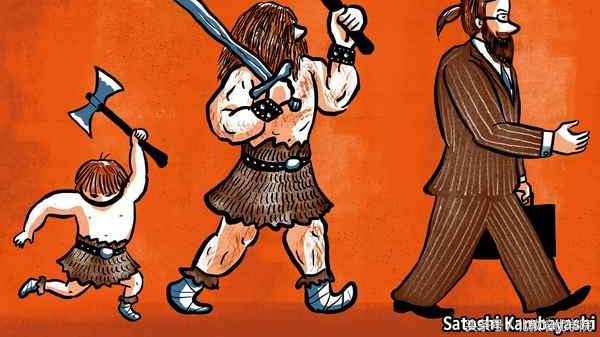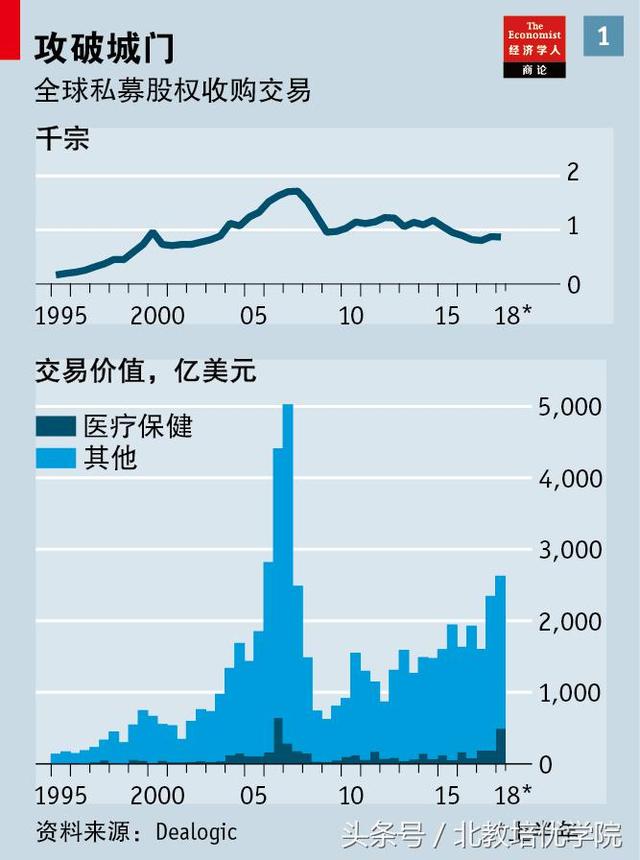Private equity
Barbarians grow up
As private-equity firms mature, the way they buy and sell is changing—as is everything in between
私募股權
野蠻人成長記
隨著私募股權公司走向成熟,其買賣方式隨之改變,其他的方方面面也在變
“SELL in May and go away,” say the denizens of Wall Street, and to the usual summer lethargy is added the excuse of a heatwave. But for those working in private equity, there is no let-up. The “shops”, as private-equity funds like to call themselves, are stuffed with money and raising more: $1.1trn in “dry powder” ready to spend around the world, according to Preqin, a consultancy, with another $950bn being raised by 3,050 firms.華爾街的人常說:“五月清倉,完事離場。” 加上熱浪來襲的借口,夏季通常都是一片慵懶怠惰。但那些在私募股權公司工作的人卻松懈不得。各家“店”(私募股權基金喜歡這樣自稱)積攢了大量資金,而且還在不斷增加。據咨詢公司Preqin的數據,除了1.1萬億美元的“幹火藥”可隨時投向世界各地,3050家私募股權公司正在另外籌集9500億美元 。
So hot is the market that there are rumours of money being turned away. Even the firms themselves, which receive fees linked to assets under management, cannot fathom how to use all that may come their way. It is not for want of trying. The year to date has seen nearly 1,000 acquisitions (see chart 1). Health care has been particularly vibrant (see next article).市場如此火爆,傳言稱有些資金都不得其門而入。私募股權公司對自己管理的資産收取管理費,連它們也不知道該怎麽利用所有這些一擁而入的資金。它們做出的嘗試並不少。今年迄今已有近1000宗收購交易(見圖表1)。醫療保健市場尤其活躍。
點擊此處添加圖片說明文字
Even more noteworthy than the volume of money pouring into private equity is the way the business is maturing. Banks are reconfiguring their operations to serve such a transaction-heavy clientele. Limited partners—the public-pension schemes, sovereign-wealth funds, endowments and family offices that provide the bulk of private-equity investment—are playing more active roles. It all adds up to a stealthy, but significant, reshaping of the financial ecosystem.相比湧入私募股權市場的資金量,更值得留意的是這項業務正在走向成熟。銀行正在重新調整業務,以便爲這個業務繁忙的客戶群提供服務。作爲私募股權投資資金的主要來源,公共養老金計劃、主權財富基金、捐贈基金和家族財富管理辦公室等有限合夥人正在發揮更積極的作用。這一切正在悄然卻顯著地重塑金融生態系統。
Data on returns are patchy. Odd measures are often used to gauge performance and disclosure is intermittent. But there is plenty of reason to believe that private-equity funds have done well in the past decade. Low interest rates have favoured their debt-heavy business model. Rising asset prices have made it easy to sell for large gains.收益方面的數據零散不全。衡量業績的手段往往稀奇古怪,信息披露時有時無。但有充分理由相信私募股權基金在過去十年裏表現不俗。低利率有利于其高債務的商業模式。資産價格節節攀升,可輕易出售獲取厚利。
And some recent clouds on the horizon have dissipated. Mooted tax reforms would have stopped private-equity firms from deducting the interest they pay on debt from their taxable income and forced their managers to pay the personal-tax rate on their investment profits (or “carried interest”), rather than the lower capital-gains rate. In the event, however, the new rules brought in last year did not touch carried interest at all and only slightly reduced the benefits of debt.不久前浮現的一些陰霾也已消散。之前醞釀的稅制改革本來要阻止私募股權公司從其應稅收入中扣除所支付的債務利息,並迫使基金經理們就其投資利潤(又稱“附帶權益”)按個人所得稅稅率而非較低的資本利得稅率繳稅。然而到頭來,去年提出的新規則並未觸及附帶權益的問題,只是略微調低了債務稅盾。
Another fear had been that regulations would become less supportive. Jay Clayton, who took over at the Securities and Exchange Commission (SEC) last year, made it clear that he wanted to see a shift towards public markets. He noted that the loss of companies to private equity had denied opportunities to small investors. A flurry of public offerings followed his appointment, including sales by private-equity firms. But the burdens of being listed remain heavy. These include onerous filing requirements and the knowledge that routine business decisions may become the subject of caustic public debate.之前另一個引人擔憂的因素是監管支持力度會減弱。去年接任美國證券交易委員會(SEC)主席的傑伊·克萊頓(Jay Clayton)明確表示希望企業回流公開市場。他指出,企業投奔私募股權,剝奪了小投資者的投資機會。在他上任後,連串公開上市隨之而來,包括私募股權公司出售的公司股權。但企業上市的負擔仍然很重,包括要應對繁瑣的申報要求,而且日常業務決策都可能引起激烈的公共爭論。
The result is that the value of public companies being taken private continues to rise (see chart 2). The figures understate the trend, since they omit the growing number of large companies selling off divisions to private-equity firms. These deals attract little attention—which is partly the point. Headquarters do not move; senior executives keep their jobs. Recent examples include the decision by J.M. Smucker, a food company, to sell its baking business to Brynwood Partners and GE’s move to sell its industrial-engines division to Advent International. Similarly unremarked is the rising number of transactions in which one private-equity firm sells to another, rather than listing an asset on the public markets.結果是上市公司被私有化的規模持續上升(見圖表2)。圖中數字並未充分反映這一趨勢,因爲其中沒有考慮越來越多的大公司將旗下部門出售給私募股權公司這一情況。這些交易很少受到關注——但在一定程度上,要的就是這樣的效果。總部不變,高管留任。最近的例子包括食品公司斯味可(J.M. Smucker)決定將其烘焙業務出售給私募股權Brynwood Partners,以及GE將其工業發動機部門出售給安宏資本(Advent International)。另外,同樣不受注意的是,私募股權公司更多地把資産出售給其他私募股權公司,而不是公開上市。
點擊此處添加圖片說明文字
Private equity’s growing heft has knock-on effects throughout the financial sector. Goldman Sachs has 25 merger bankers assigned to private-equity firms, working on deals alongside colleagues who focus on specific industries. Its analysts monitor 5,500 private-equity holdings—50% more than the number of listings on the American public markets. The other big institutional banks, such as Morgan Stanley and JPMorgan Chase, are just as attentive to private equity.私募股權公司的勢力與日俱增,在整個金融領域産生了連鎖效應。高盛有25位合並交易銀行專家被派駐到私募股權公司內,與專注特定行業的同事一起推動交易。高盛的分析師監控著5500項私募股權資産的動態,這比在美國公開市場上市的股票數量還多50%。其他大型機構銀行,如摩根士丹利和摩根大通,也對私募股權投資關注有加。
The most significant change may be in private equity’s investor base. In the past two years the number of limited partners with more than $1bn invested has grown from 304 to 359. Together they account for $1.5trn—half of all private-equity money, according to Preqin. And this statistic does not fully capture their growing activism. As well as placing cash in private-equity funds, they increasingly “co-invest”—ie, take direct stakes in a buy-out.最重要的變化可能發生在私募股權的投資者群體上。過去兩年,投資額超過10億美元的有限合夥人數量已從304增至359個。根據Preqin的數據,這些合夥人的私募股權投資總額達1.5萬億美元,占到所有私募股權資金的一半。而這一統計數據並未完全反映出他們日益積極的投資活動。除了將資金投入私募股權基金外,他們還越來越多地“共同投資”,即在並購交易中直接購入股份。
The advantage for limited partners is that they avoid management fees—often 2% annually, plus 20% of profits. Private-equity funds gain from being less reliant on each other. Not long ago, large deals often required several funds to collaborate. The purchase of Nielsen Media in 2006, for example, involved seven. That alarmed antitrust regulators, complicated management and made it hard to exit from investments, since many potential buyers were already co-owners. The value of deals done by more than one private-equity firm has fallen by half since the Nielsen deal. Even when firms work together, the average number involved is smaller than it was.有限合夥人的優勢在于可免除管理費(通常爲每年2%),另外還有20%的利潤。私募股權基金之間已經減少了對彼此的依賴,這對它們自身有利。不久以前,大宗交易往往需要多個基金合作完成。例如,2006年尼爾森媒體(Nielsen Media)的收購案就涉及七家基金。這既引來了反壟斷監管機構的關注,也令管理變得複雜,還讓退出投資變得困難,因爲許多潛在買家已經是共同所有者了。自尼爾森收購案以來,多于一家私募股權公司參與的並購的交易總額下跌了一半。即使私募股權公司合作,參與一宗並購的私募公司的平均數也少于以往。
For the biggest deals, private-equity firms are today making acquisitions solo and then syndicating large stakes through co-investments to limited partners. Notable among numerous recent examples are Blackstone’s purchase of Thomson Reuters’ finance and risk division in January for $20bn, and Carlyle’s of the specialty-chemicals division of Akzo Nobel, a Dutch multinational, in March for $12bn. The process often begins with a phone call by a private-equity firm to big, sophisticated investors such as GIC, Singapore’s sovereign-wealth fund, or CPP Investment Board, a giant Canadian pension fund. They can quickly put together teams to analyse transactions. Smaller limited partners are brought in later if needed, along with select outsiders, notably family offices.對于最大型的交易,私募股權公司如今會獨自收購,然後通過共同投資向有限合夥人分別出售大量股權。近期衆多例子中較突出的包括黑石集團(Blackstone)在1月以200億美元的價格收購了湯森路透的金融和風險部門,以及凱雷集團(Carlyle)在3月以120億美元收購了荷蘭跨國公司阿克蘇諾貝爾(Akzo Nobel)的特種化學品部門。這一過程通常始于私募股權公司致電大型資深機構投資者,如新加坡主權財富基金新加坡政府投資公司(GIC),或加拿大大型養老基金CPP投資委員會(CPP Investment Board)。這些機構可以快速組建團隊來分析交易。之後,如有需要,私募股權公司會引入較小型的有限合夥人,以及精選的外部機構——主要是家族理財辦公室。
This trend does not just reduce risk for private-equity managers. It also underlines a change in financial markets. Why should companies accept the costs and scrutiny that come with selling shares to the general public when there is a sophisticated, rich, private alternative? And when the time comes for one private-equity owner to sell, another private-equity fund can put together such a network to buy. Brokers and exchanges developed a century ago to help companies tap money where it lay—in individual pockets. Today that capital increasingly lies elsewhere.這一趨勢不僅降低了私募股權基金經理的風險,還突顯了金融市場的一個變化。既然有資金充裕而又成熟的私募渠道,企業爲何還要公開募股並接受伴隨而來的成本及審查限制?而且,等私募股權的所有者要出售手中股權時,另一個私募股權基金也可組建這樣一個私募網絡來購入。一個世紀以前,股票經紀和交易所發展起來,幫助企業募集資金——當時是從個人的口袋裏。如今,越來越多的資本聚集于別處。


